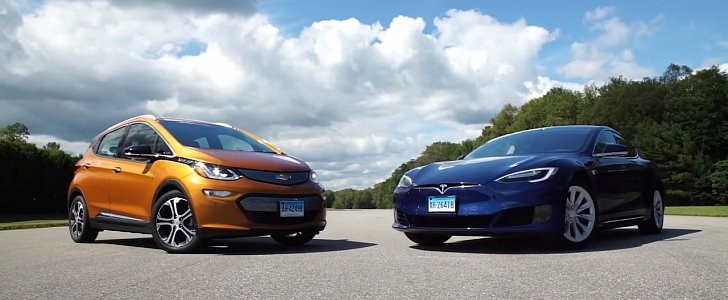Consumer Reports is widely known for its instrumented tests and comparisons. So when CR decided to pit the 2017 Chevrolet Bolt against the 2017 Tesla Model S 75D to determine real-world driving range, an odd result was to be expected.
Without further beating around the bush, the Bolt outperformed the least expensive Model S with all-wheel-drive by 15 miles. Consumer Reports ran the two electric vehicles on the publication’s standard highway route at a steady 65 mph, with the air conditioning turned off for a more consistent result. The Model S ran out of juice after a fairly respectable 235 miles, which is 24 miles less than the EPA-estimated range advertised by Tesla for the 75D.
In the General Motors corner, the compact-sized Bolt covered 250 miles before it needed a recharge. That’s not only better than the full-sized Model S with 75 kWh and Dual Motor, but better than the EPA estimate of 238 miles. To the Tesla’s defense, the Bolt is smaller, lighter, and the single electric motor is tasked with driving only the front wheels. It’s worth noting the Chevy happens to be cheaper than the Tesla, with Consumer Reports’ nicely-specced car coming at $43,155.
All in all, the surprising result shouldn’t come as a surprise to the well-informed electric vehicle enthusiast for more than one reason, especially the difference in segment and drivetrain setup between the two contenders. With all due respect to Consumer Reports, the slightly smaller Model 3 in rear-wheel-drive configuration would have been the more appropriate challenger for Chevrolet's Bolt.
Speaking of the Model 3, the newcomer has a pricing advantage, with prices starting at $35,000 before applying the $7,500 federal tax credit. The Bolt, by comparison, ups the ante to $37,495. There’s no denying the Bolt and Model 3 have “democratized” electric vehicles, but there’s still a lot to be done until the EV becomes universally accessible.
On an ending note, don't forget which of the two companies got the ball rolling for EVs. And no, I'm certainly not referring to General Motors' ill-fated EV1 from the 1990s.
In the General Motors corner, the compact-sized Bolt covered 250 miles before it needed a recharge. That’s not only better than the full-sized Model S with 75 kWh and Dual Motor, but better than the EPA estimate of 238 miles. To the Tesla’s defense, the Bolt is smaller, lighter, and the single electric motor is tasked with driving only the front wheels. It’s worth noting the Chevy happens to be cheaper than the Tesla, with Consumer Reports’ nicely-specced car coming at $43,155.
All in all, the surprising result shouldn’t come as a surprise to the well-informed electric vehicle enthusiast for more than one reason, especially the difference in segment and drivetrain setup between the two contenders. With all due respect to Consumer Reports, the slightly smaller Model 3 in rear-wheel-drive configuration would have been the more appropriate challenger for Chevrolet's Bolt.
Speaking of the Model 3, the newcomer has a pricing advantage, with prices starting at $35,000 before applying the $7,500 federal tax credit. The Bolt, by comparison, ups the ante to $37,495. There’s no denying the Bolt and Model 3 have “democratized” electric vehicles, but there’s still a lot to be done until the EV becomes universally accessible.
On an ending note, don't forget which of the two companies got the ball rolling for EVs. And no, I'm certainly not referring to General Motors' ill-fated EV1 from the 1990s.



























